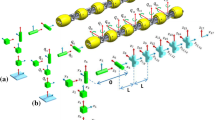Abstract
In this paper, the motion planning problem for planar snake-like robots with more than three links that is subjected to nonholonomic constraints is solved explicitly. In other words, for a given desired planar trajectory and a set of initial conditions of the snake, a unique feasible gait is generated to ensure that the origin of the snake robot’s body frame traverses that path. Additionally, the generated gait ensures that all the nonholonomic constraints are satisfied for all time.















Similar content being viewed by others
Data availibility
Data sharing is not applicable to this article since no datasets were generated or analyzed during the current study.
Change history
26 July 2021
A Correction to this paper has been published: https://doi.org/10.1007/s11071-021-06701-y
References
Ali, A., Yaqub, S., Usman, M., Zuhaib, K., Khan, M., Lee, J.-Y., Han, C.: Motion planning for a planar mechanical system with dissipative forces. Robot. Autonom. Syst. 107, 129–144 (2018)
Bazzi, S., Shammas, E., Asmar, D., Mason, M.: Motion analysis of two-link nonholonomic swimmers. Nonlinear Dyn. 89(4), 2739–2751 (2017)
Bloch, A.: Nonholonomic Mechanics and Control. Springer (2003)
Boyer, F., Porez, M.: Multibody system dynamics for bio-inspired locomotion: from geometric structures to computational aspects. Bioinspir. Biomim. 10(2), (2015)
Chitta, S., Cheng, P., Frazzoli, E., Kumar, V.: Robotrikke: a novel undulatory locomotion system. In: IEEE International Conference on Robotics and Automation (2005)
Dear, T., Buchanan, B., Abrajan-Guerrero, R., Kelly, S.D., Travers, M., Choset, H.: Locomotion of a multi-link non-holonomic snake robot with passive joints. Int. J. Robot. Res. 39(5), 598–616 (2020)
Dear, T., Kelly, S., Travers, M., Choset, H.: The three-link nonholonomic snake as a hybrid kinodynamic system. In: American Control Conference, Boston, USA (2016)
Dear, T., Kelly, S., Travers, M., Choset, H.: Locomotion of a multi-link nonholonomic snake robot. In: ASME Dynamic Systems and Control Conference, Virginia, USA (2017)
Hatton, R., Choset, H.: Approximating displacement with the body velocity integral. In: Robotics: Science and Systems, Seattle, USA (2009)
Hatton, R., Choset, H.: Optimizing coordinate choice for locomoting systems. In: IEEE International Conference on Robotics and Automation, Alaska, USA (2010)
Hatton, R., Choset, H.: Geometric motion planning: the local connection, stokes’ theorem, and the importance of coordinate choice. Int. J. Robot. Res. 30(8), 988–1014 (2011)
Hirose, S.: Biologically Inspired Robots (Snake-like Locomotor and Manipulator). Oxford University Press (1993)
Itani, O., Shammas, E.: Motion planning for a redundant planar snake robot. In: IEEE/ASME International Conference on Advanced Intelligent Mechatronics, Boston, USA (2020)
Krishnaprasad, P., Tsakiris, D.: Oscillations, se(2)-snakes and motion control. In: IEEE Conference on Decision and Control (1995)
Liljeback, P., Pettersen, K., Stavdahl, O., Gravdahl, J.: Snake robots locomotion in environments with obstacles. IEEE/ASME Trans. Mechatron. 17(6), 1158–1169 (2012)
Marsden, J., Scheurle, J.: The reduced Euler–Lagrangian equations. Fields Inst. Commun. 1, 139–164 (1993)
Marsden, J., Montgomery, R., Ratiu, T.: Reduction, symmetry, and phases in mechanics. Memoirs Am. Math. Soc. 88(436), (1990)
Ostrowski, J.: The Mechanics and Control of Undulatory Robotic Locomotion. Ph.D. Thesis, California Institute of Technology (1996)
Shammas, E.: Generalized Motion Planning for Underactuated Mechanical Systems. Ph.D. Thesis, Carnegie Mellon University (2006)
Shammas, E., Choset, H., Rizzi, A.: Natural gait generation techniques for principally kinematic mechanical systems. In: IEEE International Conference on Robotics and Automation, Orlando, Florida (2006)
Shammas, E., Oliveira, M.: Exact motion planning solution for principally kinematic systems. In: International Conference on Intelligent Robots and Systems, San Francisco, USA (2011)
Yona, T., Or, Y.: The wheeled three-link snake model: singularities in nonholonomic constraints and stick-slip hybrid dynamics induced by coulomb friction. Nonlinear Dyn. 95(3), 2307–2324 (2019)
Acknowledgements
This work was supported by the University Research Board at the American University of Beirut and the Munib and Angela Masri Institute of Energy and Natural Resources at the American University of Beirut.
Author information
Authors and Affiliations
Corresponding author
Ethics declarations
Conflict of interest
The authors declare that they have no conflict of interest.
Additional information
Publisher's Note
Springer Nature remains neutral with regard to jurisdictional claims in published maps and institutional affiliations.
Rights and permissions
About this article
Cite this article
Itani, O., Shammas, E. Motion planning for redundant multi-bodied planar kinematic snake robots. Nonlinear Dyn 104, 3845–3860 (2021). https://doi.org/10.1007/s11071-021-06515-y
Received:
Accepted:
Published:
Issue Date:
DOI: https://doi.org/10.1007/s11071-021-06515-y




